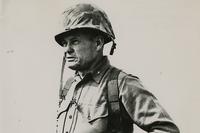Queen Elizabeth II was the longest-reigning monarch in British history, the only monarch most Britons have ever known. She ruled during a transformative period of human history and became queen of an empire at 25, an age where most of us are still paying off the Camaro we bought when we first moved into the barracks.
No other British monarch ever had to contend with fiery, nuclear death raining down on them and their subjects from space. They also never had to deal with the fact that the president of the U.S. is the most powerful office in the world. You can't just marry into an alliance like that. Forging a "special relationship" every four to eight years takes finesse.
She met 13 presidents in her lifetime and received bows or fist bumps from each of them for a reason: A record like hers commands respect, even from the Leader of the Free World. Probably one of the few things former presidents would agree on these days is their respect for Queen Elizabeth II. Here are a few military stories from her life.
1. Queen Elizabeth Was the Longest-Serving Active Military Commander.
The sovereign of the United Kingdom is the head of the British Armed Forces. As sovereign, that duty fell to Queen Elizabeth II for almost 71 years. In practice, this authority is deferred to the prime minister, but as queen, Elizabeth kept up with defense meetings and policies while approving appointments for high-ranking officers.
Until her death, she was also the only active commander in the British military who served in the British Army during World War II.
2. She Was the Only Female Member of the Royal Family to Join the Military.
When "the Blitz," the relentless Nazi bombing of England, started during World War II, there were some in the royal family who suggested Princesses Elizabeth and Margaret be evacuated to Canada for the duration of the war. Young Elizabeth wasn't having it.
Although she did leave London, Elizabeth joined the Auxiliary Territorial Service (ATS) at age 19, a women's auxiliary that was looking for bakers, postal clerks and other kinds of support. Instead of baking, Elizabeth became a driver and mechanic with a decree from the king that she receive no special treatment, despite being the presumptive heir to the throne.
The ATS wasn't necessarily a safe posting, either. Women were killed in accidents and enemy attacks, starting in 1942.
3. She Snuck Out of the Palace to Celebrate V-E Day.
Of course, she did. Anyone fighting Nazi Germany for years was going to be thrilled when World War II in Europe ended, and being the heir presumptive to the throne of the British Empire wasn't going to change that. On May 8, 1945, as throngs of British revelers took to the streets to celebrate the Allied victory over Germany, Princess Elizabeth joined them with her sister, Princess Margaret.
Although she had asked for her parent's permission, she was scared of being recognized by the public as the princesses went to Whitehall in central London to see the happy crowds.
4. Queen Elizabeth Would Later Use Her Military Skills to Terrify Saudi Royalty.
The queen didn't need a driver's license, but if she had to get one, she could have. She'd been driving since World War II, remember? Although it's not likely she drove on public roads, she had plenty of land on which to go for a spin. In 2003, during a visit from then-Crown Prince Abdullah of Saudi Arabia, she offered him a tour of Balmoral, her palace in Scotland. Instead of a chauffeur, the queen herself drove.
Queen Elizabeth might have simply wanted to drive because she could. She also might have been making a statement to the crown prince, as women were not allowed to drive in the kingdom of Saudi Arabia at the time. No matter which is true, she reportedly talked to Abdullah the whole time, ignoring his pleas to watch the winding Scottish roads, and she tore over them at any speed she wanted.

5. When the US Invaded Grenada, Queen Elizabeth Was "Furious."
Queen Elizabeth was on very good terms with President Ronald Reagan, even staying with him and first lady Nancy Reagan at their ranch near Santa Barbara, California. When Reagan authorized an invasion of the Caribbean island of Grenada in 1983, however, things got a little less special for the "special relationship."
Fears of American students becoming hostages during a power struggle on the island prompted the Organisation of Eastern Caribbean States to ask for an American intervention in the ongoing crisis. The result was Operation Urgent Fury. Though it only lasted four days, the queen was reportedly "furious," believing Reagan should have asked her, the head of state on the island, for permission.
Two years later, she visited the island anyway, backing up the actions of her friend, the U.S., without saying a word against the invasion. Now there's an ally.
-- Blake Stilwell can be reached at blake.stilwell@military.com. He can also be found on Twitter @blakestilwell or on Facebook.
Want to Learn More About Military Life?
Whether you're thinking of joining the military, looking for post-military careers or keeping up with military life and benefits, Military.com has you covered. Subscribe to Military.com to have military news, updates and resources delivered directly to your inbox.















